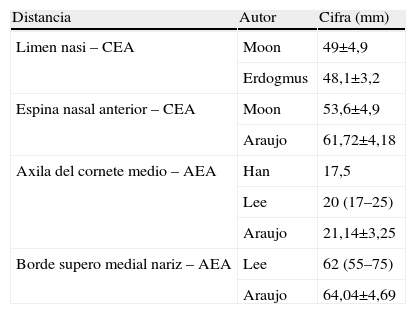La arteria etmoidal anterior presenta muchas variaciones anatómicas en su trayecto. Tampoco existen referencias claras para localizarla, por esto, es fácil producir una lesión iatrógena. El objetivo de este trabajo es realizar una búsqueda bibliográfica para analizar las variantes y referencias endoscópicas reseñadas en la literatura científica para localizarla.
Material y métodosSe ha realizado una revisión en la base de datos Medline y Embase, buscando tanto trabajos anatómicos como radiológicos. Tras la revisión se recogen los resultados de los principales estudios.
ResultadosSe recogen 13 estudios que analizan en total 1.388 arterias etmoidales anteriores. Se encuentra ausente entre un 2–14%. Es identificable entre un 95–100% en una TC. Se sitúa entre la 2.a y la 3.a lamela etmoidal en un 74,2% y a nivel basicraneal en un 66,6%. La neumatización etmoidal se relaciona con la situación de la arteria etmoidal anterior a nivel de la base de cráneo. Entre el 83–85,3% se localiza a nivel del receso suprabullar. Se exponen varias distancias y ángulos medidas para poder localizarla.
ConclusionesLa TC es útil para una planificación prequirúrgica. Se localiza más frecuentemente entre la 2.a y 3.a lamela etmoidal y a nivel basicraneal. Factores como la neumatización etmoidal o el grado de Keros pueden predecir su relación con el nivel basicraneal. La arteria etmoidal anterior, la axila del cornete medio y el borde superomedial de la nariz forman una línea recta, siendo una referencia sencilla y útil en la cirugía endoscópica.
The anterior ethmoidal artery (AEA) has a trajectory with multiple anatomical variations. In addition, there are no clear references to locate it, so it is easy to produce an iatrogenic lesion. The goal of this study was to carry out a bibliographical review to analyse variants and endoscopic reference reports in the scientific literature.
Material and methodsA review in Medline and Embase data bases was carried out, looking for AEA-related anatomical and radiological studies. After the revision, the principal study results, together with several distances and angles useful for locating the AEA, are presented in this study.
ResultsThere were 13 main articles that analysed a total of 1388 AEA. It was absent from 2 to 14%. It was identifiable in computed tomography (CT) between 95 and 100%. It was located between the second and third ethmoidal lamella in 74.2% and at the skull base level in 66.6%. Ethmoidal sinuses pneumatisation was related to AEA location at the skull base. Between 83 and 85.3%, it was found at the suprabullar recess.
ConclusionsCT is useful for presurgery planning. AEA are more frequent between the second and third lamella and at skull level. Ethmoidal pneumatisation and Keros grades could be predictive factors for AEA relationship with the skull base level. The AEA, the axilla of the middle turbinate and the superomedial edge of the nose are in a straight line, being a simple and useful reference in endoscopic sinus surgery
Artículo
Comprando el artículo el PDF del mismo podrá ser descargado
Precio 19,34 €
Comprar ahora
















